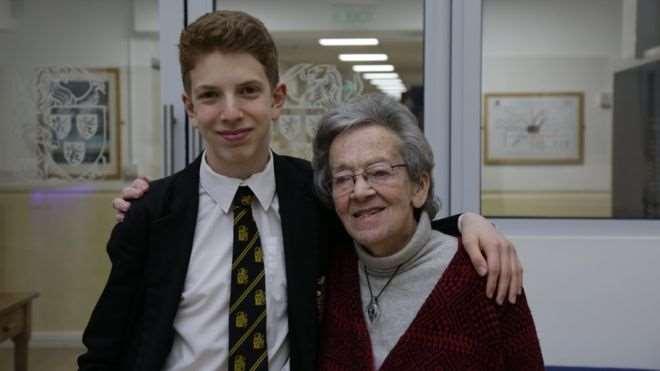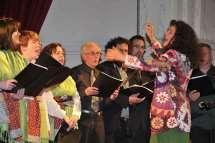
6 minute read
Belsen
11 Liberation of Bergen-Belsen 75 years ago
The British Army liberated Bergen-Belsen concentration camp 75 years ago
Seraphina, from Richmond Park Academy, reports
Bergen- Belsen was a World War II concentration camp. It was established in 1940 as a prisoner of war camp and converted to a labour camp for Jews, political prisoners, Roma gypsies and other persecuted groups from 1943. Whilst Bergen-Belsen didn’t have gas chambers, the death rates were still staggeringly high due to starvation, overcrowding and diseases such as typhus, tuberculosis and dysentery. As the population expanded from 7,300 in July 1944 to 60,000 in April 1945 rations became smaller until food and water ran out, and as a result, 50,000 people died at Bergen- Belsen. The camp was liberated by the British 11th Armoured Division on April 15th 1945. The allied forces found over 3,000 unburied corpses on arrival. In the following days there was a death rate of 500 per day and despite the work of relief teams there were still 4,000 deaths in the month following liberation. The Allied Forces made Schutzstaffel members who had run the camp bury bodies in mass graves as punishment for their crimes. A displaced persons (DP) camp was then opened for survivors that ran from 1945-1951, when all survivors had emigrated. Most went to Palestine, Canada or America. The DP camp was a thriving community in the time it was open. There was an average of 20 weddings per day in the weeks after liberation and over 2,000 children born in the following months. 2020 will mark the 75th anniversary of the liberation of Bergen-Belsen, so this is a focus of the January 2020 Holocaust Memorial Day. A 2016 study showed that only 15.2% of students associate Bergen- Belsen with the Holocaust, revealing significant gaps in Holocaust related education. In response, £1.7 million is being out towards educating the next generation about the holocaust. This involves school trips to Bergen- Belsen and projects in schools to increase awareness of the horrors of the Holocaust.
The roads and structures are full of mines and booby-traps left behind by ISIS and there are still mass graves being uncovered, adding to the tens that have already been recorded. Ariel Caine was part of the Forensic Architecture team who worked on the project. He collaborated with young men and women from Sinjar itself, most of whom were in the region during the unfolding of the ISIS genocide. Because many of the places associated with the genocide, such as mass graves surrounded by mines, were not accessible because they are still too dangerous to visit. So, Forensic Architecture and Yazda used an innovative mix of technology to solve the problem and ‘visit’ and gather Bea Green, who lives in our Borough, is a Holocaust survivor. She was born in 1924 and lived with her parents and an older brother. Bea’ evidence about the crimes committed s father was a successful lawyer and the family enjoyed holidays in their country house outside of Munich. She had from the air. “In Sinjar we used some of a nanny who took her for walks in the local park and started school when she was six. the kite aerial photography as a means to enable aerial survey under conditions However, by the time that Hitler had come to power. From that moment, Bea somehow knew that she was regarded by other where drones attract too much attention Germans not just as a Bavarian. Instead, Hitler’s regime ensured that she was seen as being Jewish first and then Bavarian… and are directly associated with profes-and being different from other Bavarians. After years of persecution Bea’s parents decided to send her to Britain on the ‘Kindertransport’ sional survey.” Using kites alongside an initiative by which thousands of childrens’ lives were saved. She is pictured with her grandson just after drones also made sense because they are cheaper to make and repair. she spoke to schoolchildren from around the Borough in 2018. Photo: Forensic Architecture
12 Marking HMD2020: Local events
Our local community is marking Holocaust Memorial Day with many events. Please see details below

Langdon Down Museum of Learning
Disability: – 27th January at 2.30pm. Finding Ivy: From Belonging and alienation and back again: tells the story of one victim of the Aktion T4 programme. Photo: Holocaust Memorial Day Trust Ivy was born in the UK and in 1930 went to live in an institution in Vienna. In 1940 she was killed at Hartheim castle near Linz. This will be followed at 3.30pm by the film Aktion T4 (see films section) Free event, booking not required. The Langdon Down Centre, Normansfield, 2A Langdon Park, Teddington TW11 9PS

Langdon Down Museum of Learning
Disability: – 27th January at 3.30pm. Aktion T4 is being shown as part of Richmond Borough’s Holocaust Memorial Day programme. In this 30-minute documentary film, Berg Kanikanian, who has Down’s syndrome, travels to Poland and Germany to visit the sites of Nazi euthanasia centres where approximately 275,000 people with learning disabilities were murdered. There will be a related talk preceding the film at 14.30hrs (see talks section) Please note
this film is not suitable for anyone under 16 years of age.
Free event, booking not required. Richmond Synagogue Year 9 Workshops (by invitation only) - 21st, 22nd and 23rd January
Landmark Arts Centre: 15th January until 2nd February 10am-3pm 75 Memorials – A Community Remembers: In commemoration of the 75th anniversary of the liberation of AuschwitzBirkenau, Richmond Council, working with the Landmark Arts Centre, will be showcasing artwork, poetry and prose submitted by schools, community groups and individuals from across the borough. This exhibition will be a moving commemoration of the Holocaust and, by featuring work from many different areas of our community, a fitting reflection on the national theme for the 2020 Holocaust Memorial Day: Stand Together.
Admission: FREE
Photo: Eric Murangwa Eugene
Landmark Arts Centre, Ferry Road, Teddington. TW11 9NN
Landmark Arts Centre: Sunday 2nd Feb-
ruary 10.30am-4.30pm ASHIRAH – I WILL SING: A special choral workshop, run by the internationally renowned Jewish choral director Polina Shepherd, will celebrate Jewish musical culture, in particular that of East European Jews. A wide range of material, sacred and secular, traditional and new will be explored in Hebrew and Yiddish, but no knowledge of the languages is necessary. Singers will be expected to take part in the evening concert at 6pm on the same day. Cost: £20. To book places please call 020 8977 7558 or email education@landmarkartscentre.org Orange Tree Youth Theatre: Sun 26th January 3pm-4pm Stand Together. As part of Richmond Boroughs’ Holocaust Memorial Day programme two of the youth groups have been exploring the 2020 HMD theme of standing together. Join us for two short brand-new pieces of theatre that have been created from scratch by young people. Tickets are FREE, booked via OT website, www.orangetreetheatre.co.uk Orange Tree Theatre, 1 Clarence Street, Richmond, TW9 2SA
Richmond Borough Library Displays Monday 20 January to Sat 1 February.
Holocaust Memorial Day displays will be mounted in East Sheen, Ham, Hampton, Richmond Lending, Teddington and Whitton libraries.
Sunday 2nd February 2020
6pm - Ashirah – I will Sing: Jewish Mu-
sic
Doors & bar open: 5.15pm An evening to mark the 75th anniversary of the liberation of Auschwitz. A special concert of Jewish secular and sacred music sung in Yiddish & Hebrew by a community choir under the direction of Polina Shepherd, an expert in Yiddish choral music & an international Jewish performer & composer. The concert will also feature Merlin Shepherd, a leading player of traditional East European Klezmer Clarinet. Organised by London Borough of Richmond & Landmark Arts Centre in aid of the Holocaust Memorial Day Trust & Landmark Arts Centre. Cost: £5 or Pay What you Can To book: https:// www.wegottickets.com/event/487240 or call 020 8977 7558





